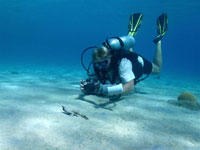This paper summarized the first five years of monitoring of the Little Cayman West End aggregation, including a summary of spawning activity, total numbers of fish present at the aggregation each year, coloration, and behavior.
This paper describes two new species of goby that were discovered by REEF surveyors during a special training project in the Veracruz Marine Park in Mexico in 2003. Individuals of the two mystery gobies were photographed by REEF's Lad Akins. In cooperation with the marine park, specimens were collected and subsequently described as new species by Dr. Mike Taylor. The new finds include a neon-type goby that hovers in shoals above coral heads (Jarocho Goby, Elacatinus jarocho) and a tiger-striped goby that rests on rocks and coral (Cinta Goby, Elacatinus redimiculus).
Though declines in coral health have been documented worldwide, the effects of this decline on reef inhabitants are poorly studied. Studies monitoring fish abundances through coral declines are often inconclusive or contradictory in their results. This study uses fish assemblage data from REEF's database, as well as bleaching data compiled by ReefBase and reef health data collected by Reef Check, to correlate reef inhabitant abundance with bleaching events. Data are analyzed with respect to species, reef location, bleaching severity, and recovery time.
This study analyzed temporal trends of the yellow stingray in the Florida Keys National Marine Sanctuary (FKNMS) as recorded by trained volunteer divers using the Roving Diver Technique. Data were obtained from the REEF Fish Survey Project. A generalized linear model on presence-absence data was used to estimate the change in yellow stingray by year. Habitat type, bottom time, depth, site, water temperature, and Julian date were included in the model to standardize the data. The decline in sighting frequency has occurred in all habitat types, depths, sites, and regions of the FKNMS.
asdfasdfassdf alksdjfalksdjflaksjf
"Did you ever have a fish experience that both excited and sadden you?"
To those who are in the know, St Vincent is considered the critter capital of the Caribbean. To those who watch fish, it is known that the rare is commonplace and that the fishwatching is unlike any other location in the Caribbean. REEF’s data from the June Field Survey supports those claims. With a team of 13 divers, the REEF group recorded an astounding 243 species, more than 65 of which were unlisted “write-ins” on the survey forms.

